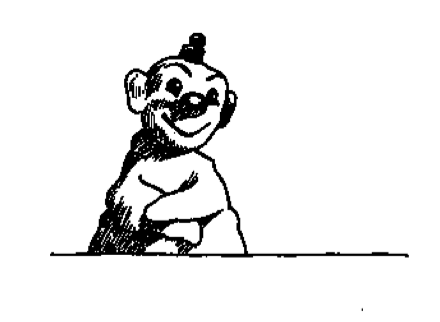For those arriving late: On some forgotten shelf of a Hollywood prop barn, there lurks a Little Clown. Waiting for someone—maybe you, maybe me—to witness the protracted discomfort of his Bedtime Ritual. He hasn’t had a victim since 1961, when Jerry Lewis, director and star of The Errand Boy, stumbled across the happy monster. Jerry gaped as the Little Clown brought up a little bed, tugged off its tiny blanket, and tried to sleep. Impossible, for the Little Clown is a hand puppet attached to a Big Arm rising from the mysterious space below. The Little Clown struggled to conceal his bulk, close his eyes, come to rest without bringing a heavy elbow into the frame. He ends by covering his eyes in a vain approximation of sleep (his eyes are painted wide open).
What does it mean? We just don’t know; the Little Clown isn’t talking. But in his awkward fumbling, perhaps lessons can be discerned offering instruction on the nature of Jerry, and even the Jerry in ourselves.
In Lesson #1: Bodies, we hypothesized the Jerry Difference. Where Chaplin, Keaton, and Laurel and Hardy propose a mode of being in the world configured around their interactions with objects, Jerry remains bodybound, acting out on impulse. His partner Dean Martin served as a stable base for his psychophysical contortions. But Dean disavowed love, which led Jerry to break up the act and left him alone with his multiplying selves. In Lesson #2: Fragmentation, we watched as Jerry’s performing persona (“the Kid”) split further as he stumbled in search of a center. We noted the paradox that his most unified film, 1963’s The Nutty Professor, should be an examination of duality. Or triality. Or quadrality. Or….
LESSON #3: EXCESS
The Little Clown is a mystery inside an enigma wrapped around a Ping-Pong ball perched on a glove with an arm inside.
“When he goes too far, he’s heaven; it’s just when he doesn’t go too far that he’s unendurable.”
—Orson Welles on Jerry
Jerry Lewis is always too much—or not enough. Jerry is the anti-Keaton. Where Buster aims to establish emotion and situation with the utmost precision and minimum display of effort, Jerry wallows around the extremes looking for (and often finding) humor within sheer overabundance of response. Buster’s face is a blank canvas on which the lightest tracings of feeling read large. Jerry’s makes every new state a shifting Greek mask of itself, mining new variations at the limit points of contortion.1 Buster conveys a transport of love by closing his eyes and taking an involuntary step backwards. Jerry grabs his head, drags his hand down his face, goes crazy-legged, and...
You have reached your article limit
Sign up for a digital subscription and continue reading all new issues, plus our entire archives, for just $1.50/month.
Already a subscriber? Sign in





